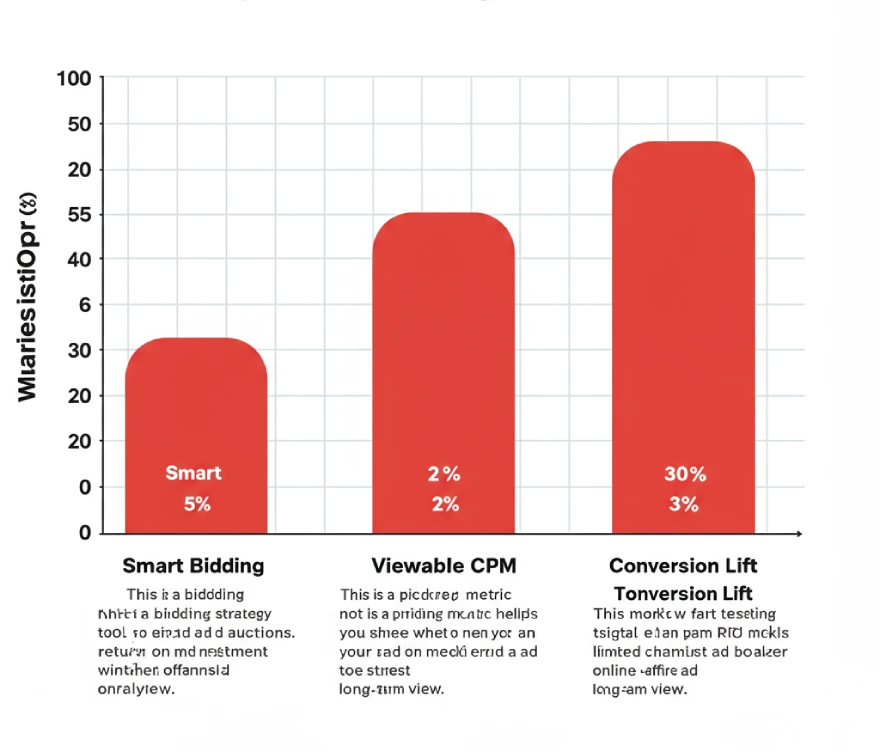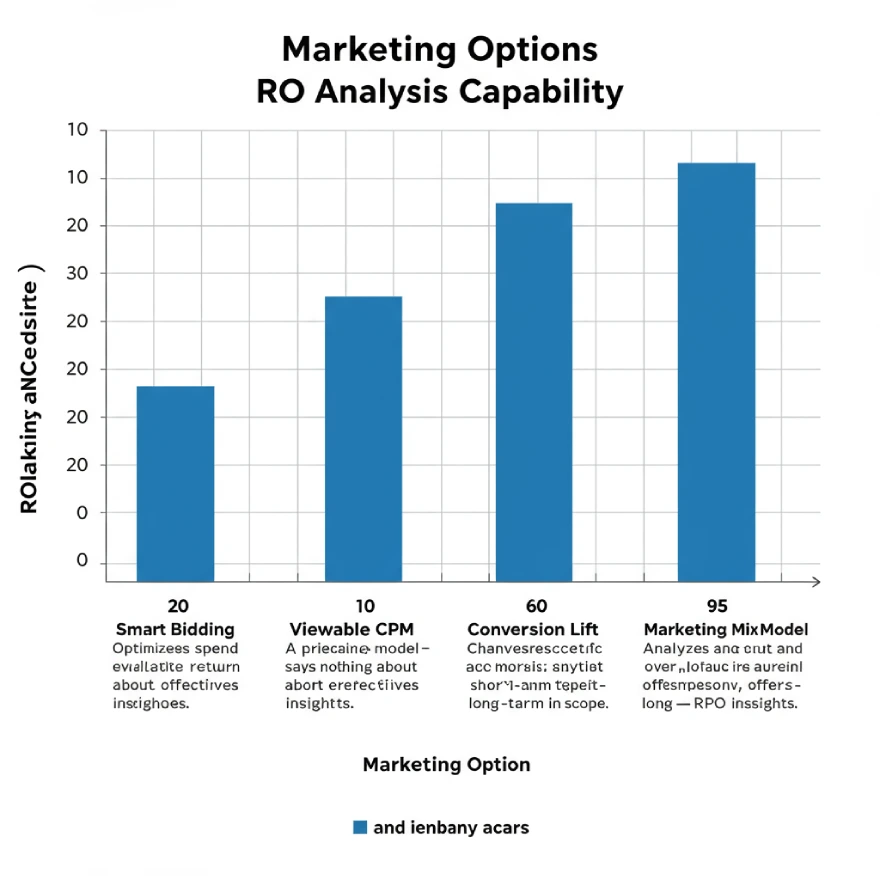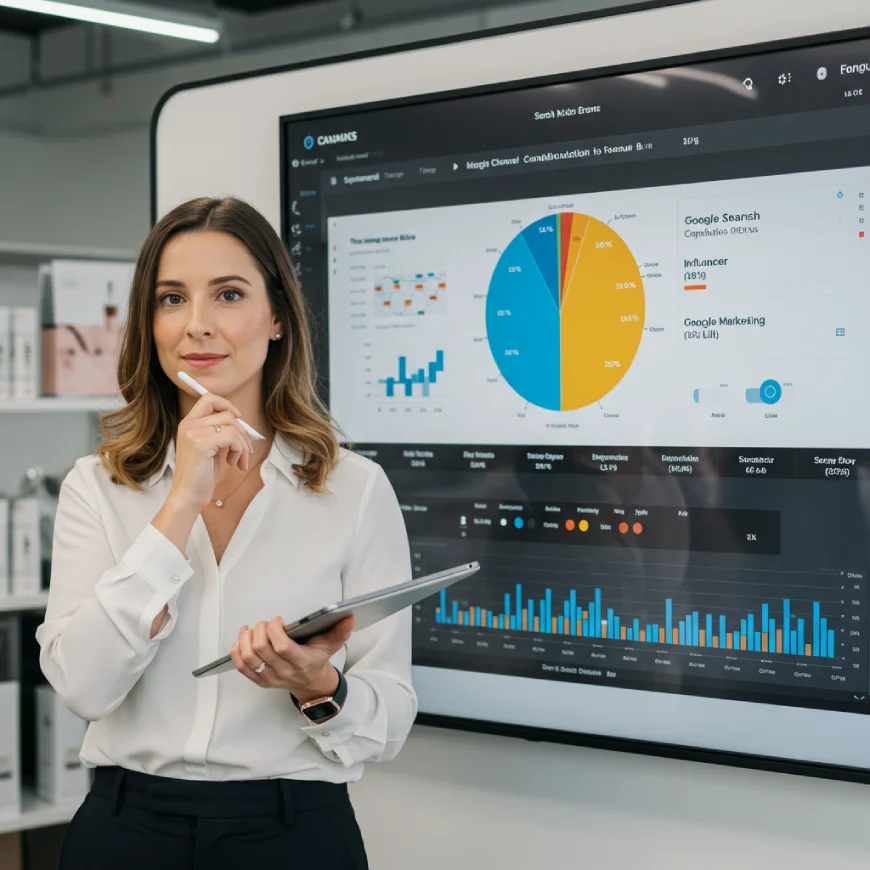The correct answer is “Marketing mix model.” But why is it right, and why not the others? This guide explains everything you need to know, based on the Google Ads Measurement Certification exam.
If you work with Google Ads or help manage media spend, it’s not always easy to tell which channels bring real results. Attribution helps, but it doesn’t show the full picture. That’s where marketing mix modeling comes in. So, no delay, let’s begin.

Table of Contents
Question from Google Ads Measurement Certification
Question:
Besides attribution, what’s another method used to analyze the return on investment (ROI) for media?
- A) Smart Bidding
- B) Viewable CPM
- C) Conversion Lift
- ✅ D) Marketing Mix Model
Correct Answer: ✅ Marketing Mix Model
Marketing Mix Modeling (MMM) is a smart, privacy-safe method to identify what truly affects your sales. It considers all factors, including ads, prices, competitors, and seasons, not just online clicks. This approach gives a complete view of your media return on investment (ROI), beyond estimates from digital campaigns.
Why the marketing mix model is the right answer
Attribution shows how someone clicked or saw your ad and later bought something. But it has limits, especially when:
- Customers shop both online and in-store
- Data privacy blocks user tracking
- Multiple things influence sales (like pricing, competitors, and holidays)
This is where Marketing Mix Modeling (MMM) becomes useful. It studies past data, compares results over time, and tells you what worked best, even across TV, print, and digital channels.
It does not track individuals but rather patterns. This makes it perfect for brands running large campaigns across multiple channels.
Why the other options are wrong
When measuring media return on investment (ROI), it’s important to separate decision-making tools from measurement methods. Only Marketing Mix Modeling provides a true, data-based way to assess media ROI across all channels. Here’s why the other options don’t work as well:
A) Smart Bidding
Why it sounds useful:
Smart Bidding uses machine learning to optimize your ad bids in real-time for better performance, especially for conversions.
Why it’s wrong for ROI measurement:
Smart Bidding is a tool for managing bids, not for analyzing results. It adjusts your spending to meet goals like cost per acquisition or return on ad spend, but doesn’t assess the overall success of your media strategy. It’s like an autopilot in a racecar; it drives well but doesn’t judge if the race was worth it.
In short:
Smart Bidding helps you spend wisely, but it does not measure if the spending was valuable.
B) Viewable CPM (Cost per Mille)
Why it sounds useful:
Viewable CPM means you pay only for ads that are actually seen, visible on-screen for at least one second for display ads, or two seconds for video ads.
Why it’s wrong for ROI measurement:
Viewable CPM is a billing metric, not a measure of performance. It shows the cost for buying media but doesn’t tell if the views caused conversions, sales, or revenue. It only confirms your ad had a chance to be seen, not that it was effective.
In short:
It shows the cost of visibility, not the value it brought.
C) Conversion Lift
Why it sounds useful:
Conversion Lift measures the added effect of an ad by comparing actions between a group that saw the ad and one that did not.
Why it’s limited for ROI analysis:
Conversion Lift is helpful for short-term tests but focuses on single channels like YouTube, Facebook, or Google Ads. It usually examines one campaign at a time for a short period. It does not provide a complete view across multiple platforms, offline campaigns, seasonal changes, or long-term trends.
In short:
It works well for testing individual digital campaigns, but it does not provide enough detail to measure the full marketing ROI across your funnel.
Summary: Why the other options are incorrect
| Option | Why It’s Not Correct for ROI Analysis |
|---|---|
| Smart Bidding | This is a bidding strategy, not a measurement tool. It helps you win ad auctions, but it doesn’t analyze return on media investment. |
| Viewable CPM | This is a pricing metric, not an ROI method. It tells you how much you pay when someone can see your ad, not whether the ad worked. |
| Conversion Lift | This method works for testing digital ads, but it’s limited to short-term and online channels. MMM offers a broader, long-term view. |

Full Summary
| Option | What It Does | Why It Fails for ROI Analysis |
|---|---|---|
| Smart Bidding | Auto-adjusts bids for conversions | Optimizes spend but doesn’t evaluate return |
| Viewable CPM | Charges only for viewable ad impressions | A pricing model — says nothing about effectiveness |
| Conversion Lift | A/B testing to measure ad impact | Channel-specific and short-term in scope |
| ✅ Marketing Mix Model | Analyzes media and external factors over time | Offers comprehensive, long-term ROI insights |

Real-Life Example: Sarah’s Beauty Brand
Meet Sarah, a marketing director at a growing skincare company. Her team manages:
- YouTube ads
- Influencer campaigns
- Google Search ads
- Discounts and seasonal offers
- TV commercials
Sales are rising, but Sarah isn’t sure what’s working. Is it the ads? Or the summer sale? Or maybe the influencer content?
So she hires a team to run a Marketing Mix Model.

What They Learn:
- TV ads contributed 30% to the quarter’s revenue
- Google Search drove 15%
- Influencer marketing gave a 10% lift
- The seasonal sale was responsible for 25%
- The rest came from organic and repeat buyers
Now Sarah knows what to fund more and where to cut back. She adjusts her budget using solid data, not guesses.
Resources to Learn More
- Modernizing your marketing mix modeling – Think with Google
Learn how marketing mix modeling helps businesses measure the true impact of their media spend across all channels. - Google Ads Help – About Conversion Lift
https://support.google.com/google-ads/answer/12005564?hl=en
Understand how Conversion Lift tests help advertisers find out if their ads really drive conversions. - Google Ads Help – About Smart Bidding
https://support.google.com/google-ads/answer/7065882?hl=en
Detailed explanation of how Smart Bidding works and how it automates bidding to hit your performance goals. - Google Ads Help – About Viewable CPM
https://support.google.com/google-ads/answer/3499086?hl=en
Breaks down how Viewable CPM works and when it’s best used in display advertising. - Google Ads – ROI Measurement Tools
https://support.google.com/google-ads/answer/14090
Explore a full range of tools and reports to measure the return on investment from your ad campaigns.
Conclusion
Measuring ROI is not just about tracking clicks or conversions. Often, the real impact on your business happens offline or goes unnoticed by usual tracking methods.
If your brand advertises on TV, runs sales events, posts on social, uses digital ads, and wants real answers, Marketing Mix Modeling gives you the big picture.
It helps you stop guessing and begin planning wisely.
I hope you understand the question and how to choose the right option. Now, if you are ready, you can take the exam on Skillshop – Google Ads Measurement Certification. If you want more real exam questions and answers like this one, which have already been covered, follow along. I’ll be breaking down more Google Ads Measurement Certification exam questions with full solutions in the next posts on Google Ads!
FAQs
Is Marketing Mix Modeling privacy-compliant?
Yes. It does not use personal or device-level data.
Can small businesses use MMM?
MMM works best for medium to large businesses with several marketing channels and at least a year of reliable data.
How is MMM different from attribution?
Attribution follows individual users. MMM examines overall business performance and identifies the factors that affected it, including offline elements.
Does Google offer tools for MMM?
Google offers MMM support via measurement partners and tools such as Google Cloud for data integration and modeling.
